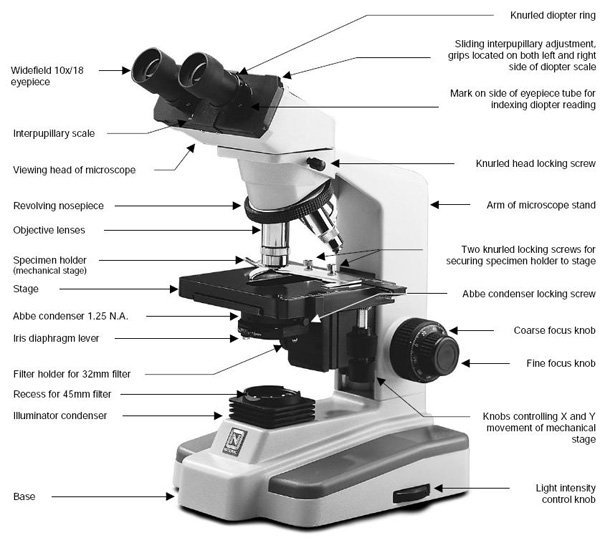The limit of resolution with unaided human eye is about
200 micrometer. 1 micrometer = 1/1000mm
= 10¯6 meter. Bacteria, being much smaller, can be visualized only
under magnification. Thus a microscope like compound microscope is required for the study of these small
organisms.
HISTORY:
Leeuwenhoek first
observed bacteria over 300 years ago using hand ground lenses.
TYPES (based on function):
Light Microscopes
Dark ground microscopes
LIGHT
MICROSCOPE
PRINCIPLE:
The
compond microscope is an instrument that magnifies images
using two lens systems. Initial magnification occurs in the objective lens. Most
microscopes have at least three objective lenses on a rotating base, and each
lens may be rotated into alignment with the eyepiece or ocular lens in
which the final magnification occurs. The objective lenses are identified as
the low-power, high-power, and oil immersion objectives.
TYPES:
Monocular
Binocular
PARTS OF COMPOUND MICROSCOPE:
1. Eye-piece
2. Nose-piece
3. Body
4. Objectives
5. Stage
6. Condenser
7. Iris-diaphragm
8. Mirror/ Built in lamp
9. Fine & course adjustments
EYE PIECE:
Structure: Two Plano convex lenses with convex side
facing each other and a field diaphragm below the lower lens. Functions:
(l) To form a magnified virtual image of the real image
formed by the objective.
(2) To carry any micrometer scale or marker to be used
with the microscope.
OBJECTIVES:
These are the lenses which are placed near the object to
be visualized. Objectives with different magnification are used in the
microscope to magnify the object.
OIL FOR IMMERSION:
1. Cedar wood oil
2. Glycerin
3. Liquid paraffin
NOTE: Cedar wood oil is preferred as medium in oil
immersion lens because it possess same refractive index as that of glass.
USES OF LIGHT MICROSCOPE:
1. For visualizing stained smears.
2. For visualizing live unstained microorganisms by hanging
drop preparation & wet mount.
LIMITATIONS OF LIGHT MICROSCOPE: Due to lack of contrast,
details cannot be appreciated.
CARE OF MICROSCOPE:
Microscope is an important instrument of precision and
care must be taken to preserve its accuracy.
1. It should be kept at uniform temperature & not
exposed to sunlight or any other source of heat.
2. When not in use, it should be protected from dust.
3. At the end of the day, objectives, eyepiece, condenser
and mirror should be cleaned by clean cotton cloth, & should not be touched
with fingers.
4. Oil immersion lens should be cleaned after use each
day by wiping with well washed fine cotton cloth or preferably with lens paper.
Oil left on a lens for a day or month, dries, becomes
sticky & finally hardens, so that it cannot be removed by simple cleaning.
On that case, cloth soaked in xylol, or benzol should be used.
NOTE: Alcohol, Acetone, chloroform and other solvents
must not be used as they may dissolve the cement holding the lens and thus
soiling the objective.
5. Dust should be removed from prism or lying internally
with the help of soft camel-hair brush or by the lens paper soaked in distilled
water.
RESOLVING POWER: 300 nm
Principle of Compound Light
Microscope
DEFINITIONS:
Absorption
When
light passes through an object the intensity is reduced depending upon the
colour absorbed. Thus the selective absorption of white light produces colored
light.
Refraction
Direction
change of a ray of light passing from one transparent medium to another with
different optical density. A ray from less to denser medium is bent
perpendicular to the surface, with greater deviation for shorter wavelengths.
Magnification
Magnification is the ability of
the instrument to give an enlarged image of the object. More the magnification,
larger will be the image of the object.
Resolution
The resolution is the ability
to identify two closely spaced dots/objects as separate. The resolving power of
the objective is its ability to resolve the details that can be measured.
Numerical Aperture
The ability of an objective to
resolve details is indicated by its Numerical Aperture. It is defined as the
ratio of the diameter of the lens to its focal length. But it is expressed
precisely by the formula
NA = n sin µ, Where,
N = refractive index of the
medium between object and objective.
µ = ½ the angle formed by two
most divergent rays of light which enters the objective.
Magnifying
power of the objective = optical tube length of microscope = 160mm/Focal length of objective (F)
For,
Low power objective = 160 mm
= x10
16 mm
High
power objective = 160 mm = x40
4 mm
Oil
immersion lens = 160 mm = x 80
2 mm
The actual focal length of oil
immersion objective is little shorter than 2 mm, thus magnification is x 100.
Magnification of the microscope
= magnifying power of the objective X magnifying power of the eye-piece.
For an eye-piece of x10
magnification, magnification of
Low power = 10 x 10 = 100
High power = 40 x 10 = 400
Oil immersion = 100 x 10 =
1000.


